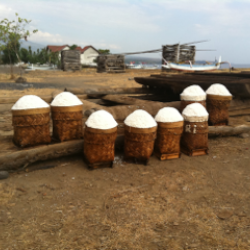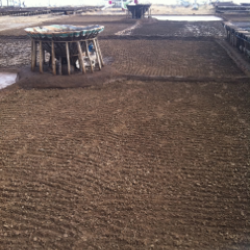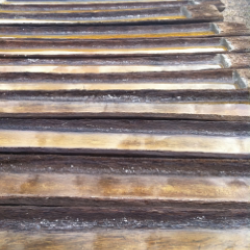

Flour Salt and Water are all that we need to make great bread. So I am on the search for the best flour/salt/water for a new baking adventure/venture.
PART 1 - Salt
JohnD wrote an interesting article regarding the varying qualities of salt. The conclusion is the minerality of sea salt was superior to river or rock salt. In my travels I have been looking for an affordable high quality salt and I am pleased to say I have found it.
My preference was to find a locally produced salt but the reality is salts in Victoria, Australia just don’t have the quality I was looking for. So I broadened my outlook to include fair trade salt. Salt that I could purchase directly from the farmer. (I figure that I can off set any resulting carbon footprint with tree planting which is already planned to compensate for the use of a wood fired oven).
Whilst on holidays on the east coast of Bali I ordered a bowl of chips and they where the best chips I have ever eaten. Not because of they were well cook, in fact the preparation was less than pleasing, oily and under cooked, but because they where covered in the most extraordinary salt. When I enquired further I was thrilled to discover that the salt was produced only a short walk from where I was staying.
Amed Sea Salt is produced on small salt farms that have been producing salt the same way for generations. At one time, several generations ago, the farms could be found scattered up and down the coast but now there are only a few left. The salt is sold almost exclusively to locals although some restaurants are now using it.
The traditional process remains unchanged with perhaps the only amendment being plastic/hesion bags are used to line the clay filters
Step 1) Harrow the clay/soil pans and fill with sea water

Step 2) Smooth the salt and soil mixture to enable even drying
Step 3) Rake the dried salt and soil to break it up
Step 4) Put broken soil into the filter cones, lining the sides. The cones are a lot like giant coffee filters

Step 5) Collect more sea water and fill the cone
Step 6) The sea water then filters through the salty soil
Step 7) Collect the filtered salty water and place into wooden containers to evaporate and reveal the salt. (the wooded containers are palm trunks that have been cut in half and carved out)

In this photo the salty water is only one day old

After 3 days the salt is visible and crystalising
Step 8) After 4 days of drying the salt is ready for collection in large 5kg baskets

The salt is a wonderful color, slightly grey and so so tasty. The local restaurants don’t use any stocks and very little additional flavoring as the salt seems to do it all.
I am looking forward to seeing how this amazing salt complements my bread.





Replies
Looking forward to how it turns out for you.
Keep us up to date .
Thanks Polenta.
I fly home tomorrow and I cannot wait to get back into it. Just hope my starter is doing OK, this is the longest period I have left it alone since it was born 3 years ago. I have a freind whos is baby sitting for me but I am sure it is missing me :)
Tim
And ? ! ! !